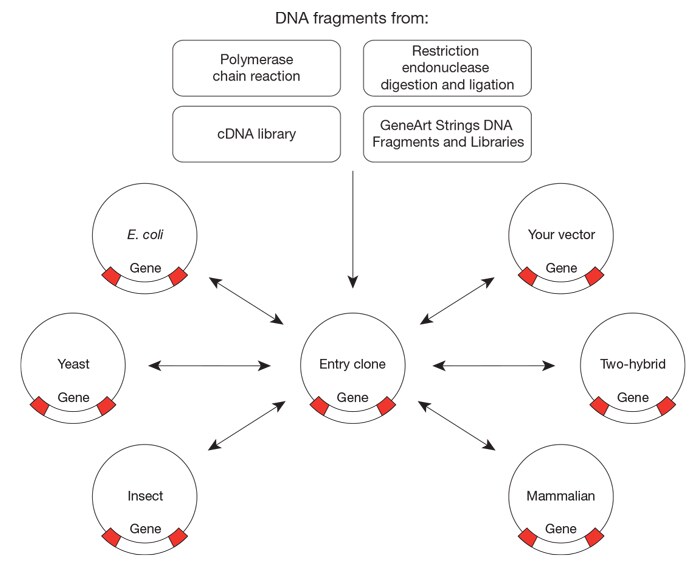Search Thermo Fisher Scientific
Gateway Recombination Cloning Technology

Invitrogen Gateway recombination cloning uses a one hour reversible recombination reaction, without using restriction enzymes, ligase, subcloning steps, or screening of countless colonies, thereby saving you time, money, and effort. Benefits include:
- 95% cloning efficiency delivers the clone you need
- Maintain orientation and reading frame throughout cloning process
- Efficient cloning of single fragments into multiple vectors simultaneously
- Flexibility to clone multiple gene fragments into a single construct
- Enter the Gateway platform via Invitrogen TOPO cloning vectors containing Gateway att sites or purchase an Thermo Scientific Ultimate ORF Clone already inserted into a Gateway vector
- New advancements such as MultiSite Gateway Technology make Gateway cloning the ideal cloning method for protein expression and functional analysis.
Gateway recombination cloning simplifies cloning workflow
The typical cloning workflow, such as traditional restriction enzyme cloning, involves many steps and can limit your cloning success. For example, certain restriction enzymes cannot be used because they might cut within your gene of interest, truncating the insert and making the gene useless for downstream expression. Additional clean-up steps are also needed, as you experience low-efficiency recovery of recombinants from cloning large fragments, and you waste time screening colonies to find the clone you need. All of these steps take considerable time and effort, and success is not guaranteed. In contrast, Gateway recombination cloning technology circumvents these cloning limitations, enabling you to access virtually any expression system.
Gateway Technology—Meet the Inventor Series
Table 1—Gateway recombination cloning vs. traditional restriction enzyme cloning.
| Steps | Gateway recombination cloning | Sub-cloning with restriction enzymes |
|---|---|---|
| Existing primers? | Yes | No |
| Vector ready for cloning? | Yes | No |
| Ligation reagents included? | Yes | No |
| Competent cells separately? | Included | Purchase separately: 0 hours Prepare: up to 6 hours |
| Vector clean up? | No | Yes |
| PCR fragment cleanup? | No | Yes |
| Recombination efficiency | Up to 95% | ~50% |
| Cloning time into expression vector* | 65 min | Up to 24 hours |
| *Excludes miniprep time common to both methods | ||
Basic cloning protocol: three steps to better efficiency
1. Determine the Entry clone
The Entry clone is how and where you start your experiment, as it contains your gene of interest or DNA fragment flanked by attL sequences, which are then used to recombine with attR sequences to create your desired expression clone. Choose one of our TOPO cloning vectors to create your Entry clone, or purchase a premade clone from our validated Ultimate ORF Clone Collection.
2. Mediate the reaction with Clonase enzymes
Once the Entry clone is ready, the gene of interest is easily shuttled to a secondary plasmid, the Destination vector. This reaction is mediated by LR Clonase enzyme mix, which contains the protein machinery necessary to excise the gene of interest from the Entry clone and integrate it into the Destination vector, which then becomes your expression clone. Reversing this reaction is simple: it requires a BP reaction (recombination between attB and attP sites) using BP Clonase enzyme mix. Both LR Clonase and BP Clonase enzyme mixes are supplied in easy-to-use master mix formats, ensuring consistency and reliability from reaction to reaction.
3. Select the Destination vector
Once you clone your gene of interest or DNA fragment into a Gateway vector, you can shuttle it to as many Destination vectors as you need (Figure 1).
From expression proteins in E. coli, yeast, insect, or mammalian cells to RNAi studies, from crystallography to protein–protein interaction functional studies, there is a Destination vector for your application. And for those applications that require a specialized or customized vector, the Gateway Vector Conversion System can convert any vector into a Gateway cloning–compatible vector.

Figure 1. Gateway technology facilitates cloning of genes, into and back out of, multiple vectors via site-specific recombination. Once a gene is cloned into an Entry clone you can then move the DNA fragment into one or more destination vectors simultaneously.
Resources
Cloning tools and resources | Related productsPublications |